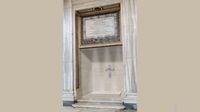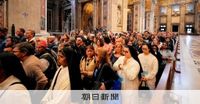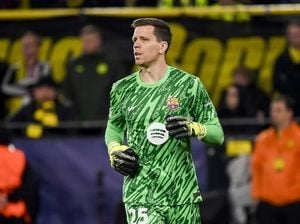The funeral of Pope Francis, who died on April 21, 2025, at the age of 88, was held in St. Peter's Square, Vatican City, starting at 10 AM local time on April 26, 2025 (5 PM Japan time). The event drew an overwhelming crowd, with the Vatican reporting that approximately 250,000 people gathered to pay their respects, including heads of state, royalty, and religious leaders from over 160 countries and regions.
Among the notable attendees were former U.S. President Donald Trump, Ukrainian President Volodymyr Zelenskyy, UN Secretary-General António Guterres, and EU Commission President Ursula von der Leyen. The Italian Ministry of Interior had implemented strict anti-terrorism measures, designating the area around the Vatican as a no-fly zone to ensure security during the funeral.
As part of the ceremony, Pope Francis's coffin, which had been placed in St. Peter's Basilica for public viewing, was closed the night before the funeral. A white silk veil covered the Pope's face, and a gold cylinder containing a certificate documenting his life was placed inside the coffin. Following the funeral Mass in the square, the Pope's remains were moved to the Basilica di Santa Maria Maggiore in central Rome for burial, marking the first time a Pope has been buried outside the Vatican since 1903.
Cardinal Rolandas Makrickas, the Archpriest of the Basilica di Santa Maria Maggiore, provided details about the Pope's tomb, which is made of stone from the Liguria region of Italy, specifically from Cogorno in the province of Genoa, the homeland of the Pope's maternal ancestors. The tombstone will bear only the name 'FRANCISCUS' and a replica of the cross that the Pope wore on his chest. This simple design aligns with the Pope's wishes for a modest resting place.
Pope Francis’s maternal great-grandfather, Vincenzo Girolamo Sivori, emigrated from Cogorno to Buenos Aires in the 19th century. Officials from Cogorno expressed their joy that the Pope kept his maternal roots in mind. The president of the Liguria Region's Aldesia Management Consortium noted that the Aldesia stone, known as 'the stone of commoners,' is characterized by its warm touch and deep, soft black tones, making it a fitting choice for the Pope's tomb.
In his will, dated June 29, 2022, Pope Francis explicitly stated his desire to be buried in the Basilica di Santa Maria Maggiore rather than in St. Peter's Basilica, where many of his predecessors are interred. He also requested a simple tomb, reflecting his lifelong commitment to humility and service.
The funeral service was a poignant reflection of the Pope's legacy, which included a strong emphasis on peace and dialogue. Just a day before his death, he had called for a just and lasting peace in Ukraine, highlighting his dedication to resolving conflicts around the world.
As the world mourned the loss of Pope Francis, many anticipated that the funeral would serve as a backdrop for diplomatic efforts regarding the ongoing conflict in Ukraine. The presence of high-profile leaders like Trump and Zelenskyy suggested that discussions about a ceasefire might take place during the event.
The Vatican also announced that 130 diplomatic missions were expected to participate in the funeral, showcasing the global impact of the Pope's influence. Among other notable figures expected to attend were Italian Prime Minister Giorgia Meloni, French President Emmanuel Macron, and UK Prime Minister Keir Starmer.
In a significant change to the traditional burial process, Pope Francis had revised the liturgical guidelines in April 2024 to simplify the rituals following his death. This time, his remains were placed in a single wooden coffin with a lead lining, rather than the customary three-coffin arrangement. The coffin was displayed open for public viewing at St. Peter's Basilica, and the lid was closed the day before the funeral.
The funeral Mass included hymns sung in honor of the late Pope, and after the service, the coffin was transported to its final resting place. The nine days following the funeral, from April 26 to May 4, 2025, have been designated as a mourning period, during which prayers will be offered daily for the Pope.
Looking ahead, the election of a new Pope, known as the 'conclave,' is expected to take place soon. This election will be conducted by cardinals under the age of 80 and is typically held 15 to 20 days after the Pope's death. There is speculation that this conclave could begin between May 6 and May 11, 2025, although it may start earlier if the cardinals are ready.
Potential candidates for the next Pope include Cardinal Pietro Parolin, who served closely with Pope Francis as Secretary of State, and Cardinal Matteo Maria Zuppi, who has been involved in diplomatic efforts related to Ukraine. Other names mentioned include Cardinal Luis Antonio Tagle from the Philippines, known as 'Asia's Francis,' and Cardinal Peter Turkson from Ghana, who could become the first Pope from Africa.
The voting will occur in the Sistine Chapel, and when a new Pope is elected, white smoke will rise from the chapel's chimney, signaling the conclusion of the conclave. As the world reflects on the legacy of Pope Francis, the selection of his successor will mark a pivotal moment for the Roman Catholic Church and its followers globally.





